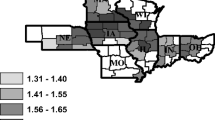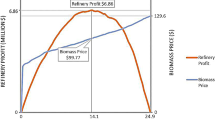Abstract
We evaluate how different contract designs impact risk sharing along the supply chain for the dedicated energy crop miscanthus. We model the full production and transportation system of the miscanthus supply chain because a sustainable supply chain must procure biomass in a cost-effective manner. Using this model, we estimate the financial returns and risks for both a farmer producing miscanthus and the biofuels plant purchasing miscanthus. We evaluate differences among contracts that are designed to address the miscanthus investment cost and the farmers’ opportunity costs. We find that risk can be reduced to both the farmer and the plant by offering a dollar per acre base payment combined with a dollar per ton payment. The farmer faces the lowest risk when the contract combines a dollar per acre and dollar per ton payment. Lastly, we find that indexed contracts designed to reduce annual counter-party risk associated with the risk of farmers opting out of the contract to produce competing crops actually increases overall financial risk to the farmer and plant.
Similar content being viewed by others
Notes
Interest in miscanthus is driven by its photosynthetic and nitrogen use efficiency. Miscanthus can achieve yields in the excess of 10 dry matter (DM) tons/acre/year on relatively poor quality soils.
References
Sherrington C, Bartley J, Moran D (2008) Farm-level constraints on the domestic supply of perennial energy crops. Energy Policy 36:2504–2512
Yang X, Paulson N, Khanna M (2012) Optimal Contracts to Induce Biomass Production under Risk. Selected Paper prepared for presentation at the Agricultural & Applied Economics Association’s 2012 AAEA&NAREA Joint Annual Meeting, Seattle, WA, August 12-14, 2012
Larson JA, English BC, He L (2008) Risk and Return for Bioenergy Crops under Alternative Contracting Arrangements. Selected Paper prepared for presentation at the Southern Agricultural Economics Association Annual Meetings, Dallas, TX, February 2-6, 2008
Bocqueho G, Jacquet F (2010) The adoption of switchgrass and miscanthus by farmers: Impact of liquidity constraints and risk preferences. Energy Policy 38:2598–2607
Fewell J, Bergtold J, Williams J (2011) Farmers’ Willingness to Grow Switchgrass as a Cellulosic Bioenergy Crop: A State Choice Approach. Selected Paper prepared for presentation at the 2011 Joint Annual Meeting of the Canadian Agricultural Economics Society & Western Agricultural Economics Association, Banff, Alberta, Canada, June 29-July 1, 2011
Alexander C, Ivanic R, Rosch S, Tyner W, Wu SY, Yoder JR (2011) Contract theory and implications for perennial energy crop contracting. Energy Econo. doi:10.1016/j.eneco.2011.05.013
Griffith AP, Larson JA, English BC, McLemore DL (2012) Analysis of contracting alternatives for switchgrass as a production alternative on an East Tennessee beef and crop farm. AgBioforum 15(2):206–216
MacDonald J, Perry J, Ahearn MC, Banker D, Chambers W, Dimitri C, Key N, Nelson KE, Southard LW (2004) Contracts, Market, and Prices: Organizing the Production and Use of Agricultural Commodities. United States Department of Agriculture
Kreps DM (1990) A course in microeconomic theory. Princeton University Press, Princeton
Johnson CS, Foster KA (1994) Risk preferences and contracting in the U.S. Hog Industry. J Agric Appl Econ 26(2):393–405
Parcell J, Langemeier M (1997) Feeder-pig Producers and Finishers: Who Should Contract? Can J Agric Econ 317-27
Perrin R, Vogel K, Schmer M, Mitchell R (2008) Farm-scale production cost of switchgrass for biomass. Bioenergy Res 1(1):91–97
Guide to Using @Risk: Risk Analysis and Simulation Add-In for Microsoft Excel. Ithaca: Palisade Corporation. 2010. Available at: http://www.palisade.com/downloads/manuals/EN/RISK5_EN.pdf
Idaho National Laboratory Bioenergy Program (2009) Uniform-format feedstock supply system design for lignocellulosic biomass. U.S. Department of Energy, Idaho Falls
Jain AK, Khanna M, Erickson M, Huang H (2010) An integrated bio-geochemical and economic analysis of bioenergy crops in the Midwestern United States. Bioenergy. doi:10.1111/j.1757-1707.2010.01041.x
University of Kentucky Cooperative Extension Service (2009) Custom Machinery Rates Applicable to Kentucky (2009). University of Kentucky
Ivanic R (2009) Personal communication, interviewed by J.R. Yoder
Indiana State Climate Office (2000-2009) Climatological Data: Indiana
Richardson JW, Klose SL, Gray AW (2000) Procedure for estimating MVE probability distributions. J Agric Appl Econ 32(2):299–315
Tiffany DG (2007) Economic Comparison of Ethanol Production from Corn Stover and Grain. AURI Energy Users Conference, Redwood Falls, MN
Schurle B (1996) The impact of size on yield variability and crop insurance premiums. Rev Agric Econ 18(3):415–422
Guide to Using RISKOptimizer: Simulation Optimization for Microsoft Excel. Ithaca: Palisade Corporation. 2010. Available at: http://www.palisade.com/downloads/manuals/EN/RISKOptimizer5_EN.pdf
National Agricultural Statistics Service, USDA (2009) NASS Quick Stats. United States of America
Clark SF (2009) The profitability of transitioning to organic grain crops in Indiana. Am J Agric Econ 91(5):1497–1504
Dobbins C (2009) Average Estimated Cash Rents Per Acre By Geographic Areas and Land Class. Purdue Agricultural Economics Report, Purdue University. Available at: http://www.agecon.purdue.edu/extension/pubs/paer/2009/august/dobbins.asp
Blanco C, Soronow D (2001) Mean Reverting Processes- Energy Price Processes Used for Derivatives Pricing and Risk Management. Commodities Now
Acknowledgments
The authors gratefully acknowledge the financial support of Mendel Biotechnology, Inc. This article is based on Joshua Yoder’s master’s thesis.
Author information
Authors and Affiliations
Corresponding author
Rights and permissions
About this article
Cite this article
Yoder, J.R., Alexander, C., Ivanic, R. et al. Risk Versus Reward, a Financial Analysis of Alternative Contract Specifications for the Miscanthus Lignocellulosic Supply Chain. Bioenerg. Res. 8, 644–656 (2015). https://doi.org/10.1007/s12155-014-9548-z
Published:
Issue Date:
DOI: https://doi.org/10.1007/s12155-014-9548-z




